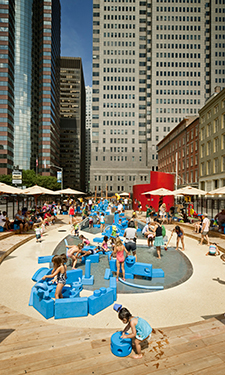 In the aftermath of the terrorist attacks on September 11, 2001, renowned architect David Rockwell felt the same acute sense of vulnerability and loss as his fellow New Yorkers. The founder and CEO of The Rockwell Group spent his career designing some of the world’s most incredible spaces, but after 9/11, he turned his attention to helping mend the architectural wounds of lower Manhattan. The confluence of tragedy, Rockwell’s talent and the recent contemplations he’d been entertaining while observing his children at play led to an exciting new design endeavor. Rockwell’s Imagination Playgrounds posit a different sort of playground — one constructed by the children themselves. “There were so many great traditional play spaces, but few where kids could manipulate their environments,” Rockwell says. “So, I started exploring different kinds of play spaces and an idea for a playground that encouraged more free play and imagination.” Imagination Playground kits include a moveable collection of parts that can be used indoors or outdoors, on any safe surface. Dozens of bright blue, oddly shaped polyethylene foam blocks make up the sets, and they are “biodegradable and resistant to heat, mold, mildew and micro-organisms,” Rockwell adds. Children can stack, connect and manipulate the blocks into whatever structures they like, allowing the organic creation of play space in a collaborative spirit.
In the aftermath of the terrorist attacks on September 11, 2001, renowned architect David Rockwell felt the same acute sense of vulnerability and loss as his fellow New Yorkers. The founder and CEO of The Rockwell Group spent his career designing some of the world’s most incredible spaces, but after 9/11, he turned his attention to helping mend the architectural wounds of lower Manhattan. The confluence of tragedy, Rockwell’s talent and the recent contemplations he’d been entertaining while observing his children at play led to an exciting new design endeavor. Rockwell’s Imagination Playgrounds posit a different sort of playground — one constructed by the children themselves. “There were so many great traditional play spaces, but few where kids could manipulate their environments,” Rockwell says. “So, I started exploring different kinds of play spaces and an idea for a playground that encouraged more free play and imagination.” Imagination Playground kits include a moveable collection of parts that can be used indoors or outdoors, on any safe surface. Dozens of bright blue, oddly shaped polyethylene foam blocks make up the sets, and they are “biodegradable and resistant to heat, mold, mildew and micro-organisms,” Rockwell adds. Children can stack, connect and manipulate the blocks into whatever structures they like, allowing the organic creation of play space in a collaborative spirit.
The flagship Imagination Playground at Burling Slip in Manhattan was a collaboration between Rockwell’s design firm and the New York City Department of Parks and Recreation. It would be the first of now more than 1,200 Imagination Playgrounds across the United States, as well as at schools and orphanages in Haiti and Bangladesh, and other international locations.
“Children in post-disaster areas must have a sense of normalcy to recover,” Rockwell says. “Allowing kids, who have no control over their immediate environment, to have control over creating something has made a big impact.” Learn more about Imagination Playgrounds.
— Samantha Bartram, Associate Editor of Parks & Recreation Magazine

